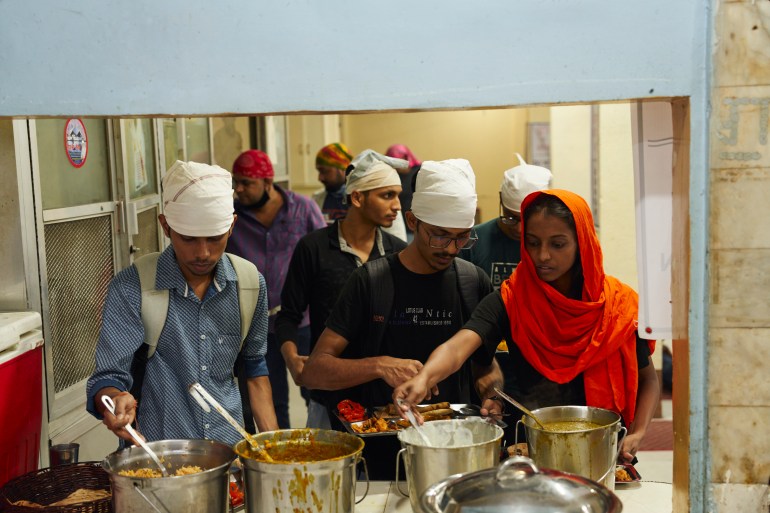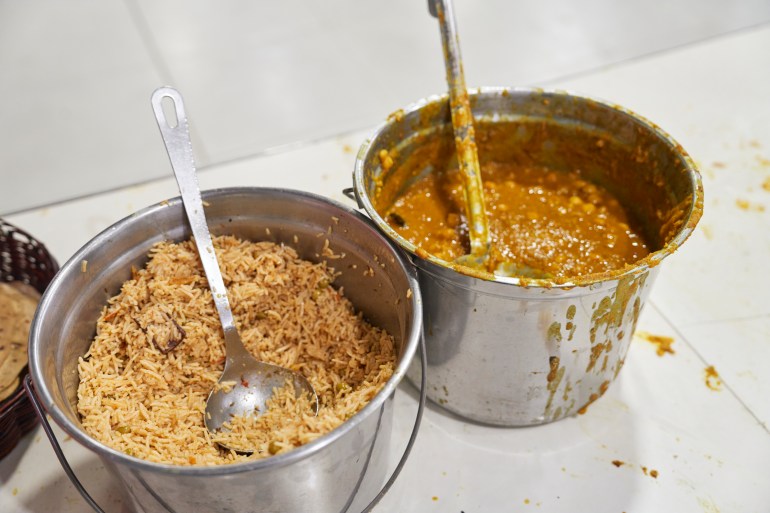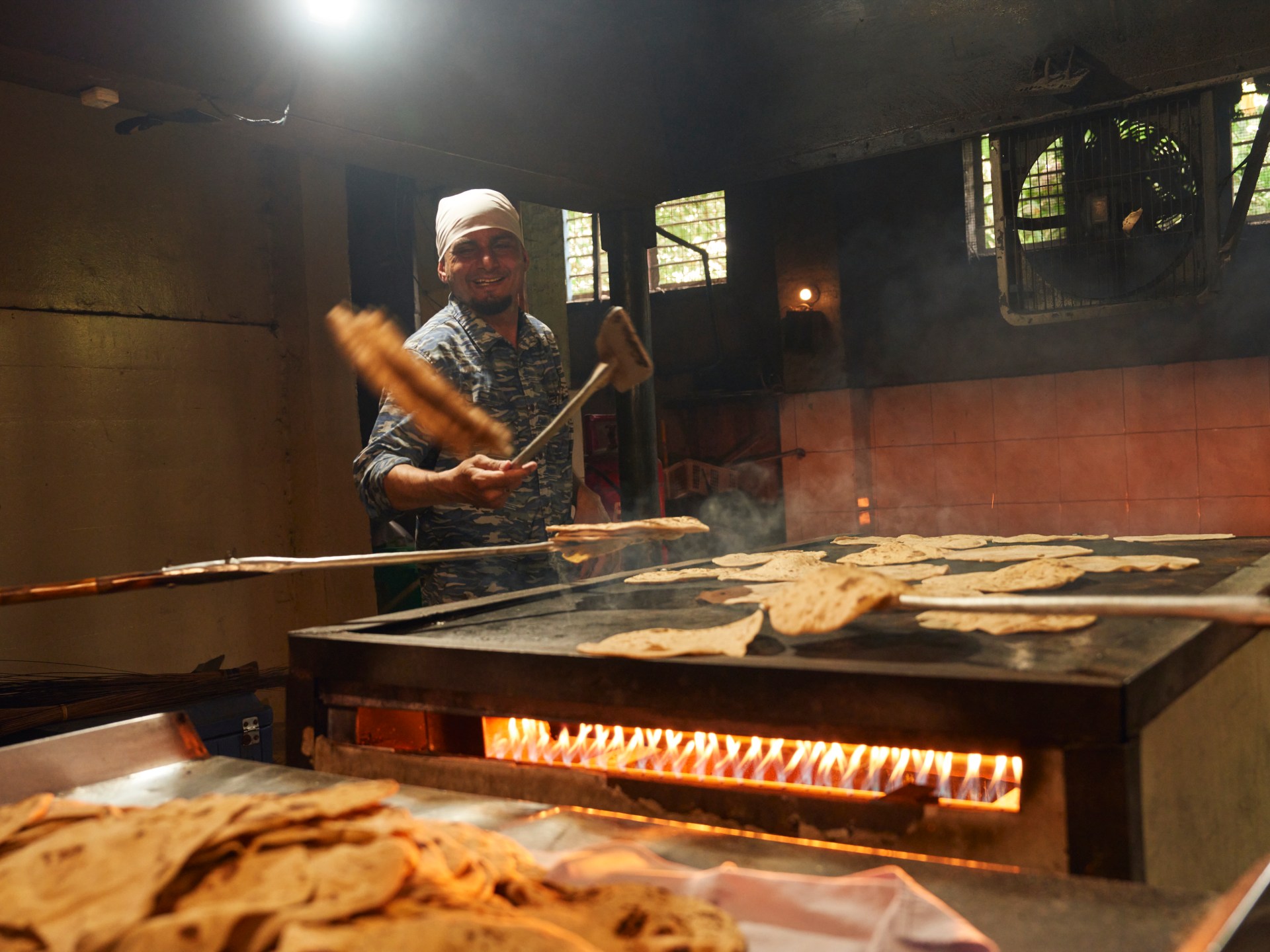Manila, Philippines – “Don’t deal with this like a full dinner. Solely take small parts,” a mom warns her son as he reaches for a second serving to of zarda – saffron-hued, sweetened rice topped with heaps of raisins and cashews – on the crowded buffet-style desk on the Khalsa Diwan Temple in Manila. “We should not waste something.”
I overhear her whereas standing in line to pattern the completely different forms of barfi, a dense, milk-based fudge laden with sliced almonds – a preferred candy from the Indian subcontinent. The mom and son are among the many 100-plus members of the Metro Manila Sikh group who’ve gathered right here in late August to rejoice the Parkash Utsav of Guru Granth Sahib, a commemoration of the primary opening ceremony of Sikhism’s central non secular scripture.
It’s a busy day for the group kitchen, the langar. Dozens of volunteers snake their means by means of the gang to serve rotis, recent off the tandoor. Sitting cross-legged in rows throughout the principle corridor of the gurdwara, or Sikh place of worship, attendees dip roti into shahi paneer, a creamy curry with pockets of arduous cheese, or fortunately spoon up the gajar ka halwa, a aromatic carrot pudding, neatly portioned off inside giant metal trays.
Surveying the room, I momentarily overlook that I’m within the Philippines.

The start – and longevity – of moneylending in Manila
Based in 1929 by a small group of Punjabi migrants, Khalsa Diwan Temple is Manila’s oldest gurdwara. It marked the start of a budding Sikh group within the Philippines.
Punjabi migrants, who kind the majority of the India diaspora inhabitants within the Philippines (practically 82 p.c), started to trickle into the nation within the Twenties, explains Joefe Santarita, a professor on the Asian Middle on the College of the Philippines Diliman. First, they tried their hand at farming, then moved to small-scale companies.
“From that have”, Santarita says, “they realised Filipino households wanted cash.” A shift in the direction of moneylending seemingly occurred throughout World Warfare II when there was an pressing want for capital amongst micro-entrepreneurs in rural areas, he provides.
Whereas monetary inclusion within the Philippines has improved dramatically since then, 44 p.c of Filipinos didn’t have entry to a proper checking account as not too long ago as 2021, in response to the Philippine central financial institution, Bangko Sentral ng Pilipinas.
The Punjabi migrants tapped right into a constant demand from this unbanked group, providing loans for small-scale entrepreneurs or micro-enterprises – and never asking for paperwork or collateral. To compensate, loans are provided at a hefty 20 p.c curiosity.
In the present day, the moneylending group is interwoven all through the Philippines, even when it largely sits on the fringes of the legislation. Moneylenders at the moment are an integral a part of the nation’s casual financial system, zipping by means of neighbourhoods on their motorbikes to solicit new shoppers and repair present ones. They function on an off-the-cuff foundation with none permits, usually cultivating new shoppers by providing numerous items, equivalent to small electrical home equipment, on instalments.
The returns are so profitable, many Indian migrants, principally from the state of Punjab, transfer to the Philippines to pursue moneylending.
Nonetheless, no enterprise occurs on the gurdwara, which capabilities as an anchor of the Sikh group. Right here, the moneylenders depart their work behind to carry out sewa (“selfless service” in Punjabi). A technique is to assist maintain the massive group kitchen operating as a spot the place anybody, no matter non secular denomination, can get a free meal.
![The main dining hall at the Khalsa Diwan Sikh Temple in Manila, Philippines [Sonny Thakur/Al Jazeera]](https://www.aljazeera.com/wp-content/uploads/2024/01/STST_Fork_0169-Manila-moneylenders-Sonny-Thukar-1705945654.jpg?w=770&resize=770%2C513)
After I go to the gurdwara once more on a February afternoon, the langar is quiet. A small group of Indian medical college students sits cross-legged, dipping thick entire wheat chapati right into a mashed masoor dal. The dal is straightforward however flavourful, spiced with heaps of onion, garlic and crimson chilli powder. The meals on the gurdwara is completely different from again residence of their state of Andhra Pradesh on India’s southeastern coast, however they’re having fun with it. The standard, they are saying, retains them coming again.
“It’s additionally free,” Vikram Seetak, the temple’s head, jogs my memory after I inform him the scholars love his meals. Seetak has been working within the gurdwara kitchen since 1999. Not like nearly all of his friends on the gurdwara, Seetak didn’t go into moneylending. After shifting to Manila from a small city close to Jalandhar in japanese Punjab, the place he labored at his household’s mithai (sweets) store, he took up a job on the close by South Asian grocery retailer. After just a few months, he grew to become a full-time cook dinner at Khalsa Diwan.
![The fresh produce used for meals at the Khalsa Diwan Skih Temple Manila is provided by community volunteers [Sonny Thakur/Al Jazeera]](https://www.aljazeera.com/wp-content/uploads/2024/01/STST_Fork_0013-Manila-moneylenders-Sonny-Thukar-1705944549.jpg?w=770&resize=770%2C513)
Seetak now heads a workforce of eight: a mixture of Indian-origin and Filipino cooks, one in all whom has labored with him for the previous 20 years. He likes being in command of the kitchen. “I’ve to do the blending of the spices myself,” he tells me whereas straining a thick batter of gram flour and sugar syrup into a big deg, a thick aluminium pot.
He’s making badana, extra generally generally known as boondi – bite-sized, sharply sweetened, fluorescent orange balls – in preparation for the weekend’s festivities. Along with catering a marriage on the gurdwara, Seetak and his workforce are gearing as much as rejoice the start, in 1630, of the seventh Sikh guru, Guru Har Rai.
![Bikram, who runs the kitchen at the Khalsa Diwan Sikh Temple in Manila, watches over the last batch of food from the morning’s cook. [Sonny Thakur/Al Jazeera]](https://www.aljazeera.com/wp-content/uploads/2024/01/STST_Fork_0051-Manila-moneylenders-Sonny-Thukar.-1705944996.jpg?w=770&resize=770%2C513)
By late afternoon, the gurdwara is teeming with volunteers making ready meals. They chop tomatoes and onions and kind heaps of spinach to organize a gurdwara staple: palak pakoray (spinach pakora), which is spinach leaves dipped in a gram flour batter, spiced with roasted coriander seeds and crimson chilli powder after which fried. There may also be vegetarian “mutton”.
“It needs to be a full vegetarian menu,” Seetak says in response to my quizzical look. “So we get a mutton substitute product of soybean.”
Whereas Sikhism doesn’t mandate vegetarianism, all gurdwaras serve solely vegetarian delicacies to accommodate the dietary restrictions of individuals from completely different faiths in addition to members of their very own group. Even in Manila, some Sikhs select to be vegetarian of their properties regardless of the predominantly omnivorous tradition of the Philippines.

Contained in the gurdwara workplace, group volunteer Jagjit Singh, a first-generation Indian Filipina, is standing with the secretary at a laptop computer reviewing the substances they should purchase to organize pancit, Filipino-style noodles. “Sesame oil, cauliflower, carrots, calamansi, Baguio beans,” she narrates in fluent Tagalog. As a result of pancit is usually ready with sliced meat or seafood, the meat substitute can be a vegetarian tapa (jerky), additionally made with soybeans.
A altering Indian meals tradition within the Philippines
Singh was born and raised in Manila and now lives along with her husband, Shomkor, a Sikh moneylender, in Cavite, a close-by province to the south. Not like a lot of her Sikh group members, Singh is a Philippine citizen and firmly identifies as an Indian Filipina. Her father moved to the Philippines from japanese Punjab on the age of 5 together with his mother and father. Each Singh’s father and grandfather grew to become moneylenders.
“I really miss Filipino meals after I go to India,” Singh tells me. “We prefer to have a mixture of each at residence.”
Within the morning, she and Shomkor begin with a Punjabi-style breakfast, equivalent to aloo poori, a vibrant and spicy potato curry with puffy, deep-fried bread. For lunch, they change to Filipino meals: adobo, menudo or mechado – wealthy, Philippine-style stews ready with meat. And within the evenings, it’s a toss-up.
Singh and her husband are omnivores. “Although my husband took Amrit [an initiation ceremony that comprises one of Sikhism’s four religious rites], he likes to eat meat,” she says, including that he “really prepares Filipino dishes fairly nicely”.
The apply of vegetarianism after taking Amrit varies. Some sects are vehemently towards consuming meat and eggs whereas others are usually not.
Manor Singh, one other temple member and moneylender, and his spouse are strict vegetarians. Initially from Jalandhar in japanese Punjab, Manor Singh adopted his uncle in 1999 to Manila, the place he bought his begin in moneylending. Regardless of having lived within the Philippines for greater than 20 years, Manor and his spouse eat vegetarian meals. This could embrace the whole lot from cauliflower and peas in a spiced tomato-onion base to kadhi chawal, flippantly spiced gram flour fritters nestled in a turmeric-hued yoghurt curry.
![A large pot of saag simmers as a volunteer uses a large drill to stir the dish thoroughly [Sonny Thakur/Al Jazeera]](https://www.aljazeera.com/wp-content/uploads/2024/01/STST_Fork_0031Manila-moneylenders-Sonny-Thukar.-1705944702.jpg?w=770&resize=770%2C513)
In what can be the winter in Punjab, the Singhs take pleasure in makki ki roti (stiff roti made with cornmeal) paired with sarson ka saag (slow-cooked mustard greens and spinach topped with sliced garlic tempered in ghee).
They can discover all the required spices at a South Asian grocery, which has six areas throughout metro Manila. Earlier than the chain opened, Manor Singh remembers the proprietor promoting spices straight from his van outdoors the gurdwara. Through the years, many South Asian grocery shops have popped up within the neighbourhood.
“Oh, you get the whole lot within the Philippines!” says Ritu Wasu, who runs the Indian restaurant Harishi along with her husband and daughter. She sits within the gurdwara workplace along with her buddy who runs a small Indian catering enterprise.
For the previous 5 years, Harishi has been serving up a mixture of North and South Indian delicacies to a clientele of Indians and Filipinos. “By the point we opened the restaurant, Filipinos have been already acquainted with Indian meals. They particularly ask for hen biryani,” she tells me.
Some speculate that biryani’s reputation within the Philippines could be attributed to Filipinos’ publicity to Indian meals whereas working in Gulf states. “They go to Saudi Arabia and get a style of biryani and are available in search of it again within the Philippines,” a group member explains.
![Fried pakodas from the Khalsa Diwan Sikh Temple kitchen in Manila, Philippines A large pot of saag simmers as a volunteer uses a large drill to stir the dish thoroughly [Sonny Thakur/Al Jazeera]](https://www.aljazeera.com/wp-content/uploads/2024/01/STST_Fork_0043-Manila-moneylenders-Sonny-Thukar.-1705944872.jpg?w=770&resize=770%2C513)
Rooster and rice are a preferred pairing within the Philippines. What higher introduction to South Asian meals than richly spiced hen layered into fluffy basmati rice?
“Filipinos have come to like Indian meals,” Santarita says.
Acceptance and assimilation
Regardless of being a typical fixture for nearly a century, the Punjabi moneylending group remains to be considered by some with a degree of suspicion. Though the gurdwara group members determine themselves as “Bumbays” (derived from town Mumbai) or “5-6” (“you’re taking 5, pay again six” with curiosity), each are thought of largely derogatory phrases in the remainder of the Philippines.
In 2017, then-Philippine President Rodrigo Duterte known as for the arrest of “Bumbay” moneylenders. Opinion items and editorials calling for an finish to “Bumbay mortgage sharks” additionally began appearing in main newspapers across the identical time.
Filipino youngsters, in the meantime, have all the time grown up listening to “Behave, or I’ll name the 5-6!”
Jagjit Singh, who feels well-integrated into the Philippines, believes there was a shift in angle lately. “It’s not like that any extra. Now youngsters will as a substitute inform mother and father they are going to ship the Bumbays after them. … There isn’t a longer that worry of us,” she says.
Some declare that Duterte’s marketing campaign towards the 5-6 was profitable, largely because of the launch of a competing lending scheme by the federal government’s Division of Commerce and Business and the Securities and Trade Fee’s broader efforts to manage lending actions moderately than perform wholesale arrests of small-scale moneylenders. Santarita believes Duterte’s orders for arresting “Bumbay mortgage sharks” was principally rhetoric.
“It’s troublesome to cease the moneylending and from Bumbays conducting enterprise as a result of there’s a dire want of capital amongst clients who’re thought of unbanked,” Santarita says. Along with an absence of entry to formal financial institution accounts, borrowing from formal establishments is expensive and cumbersome with excessive collateral and burdensome documentary necessities. The important operate of micro-financing partially helps clarify why Indian and Indian-origin moneylenders proceed to function with out permits.
![Motorbikes parked outside the Khalsa Diwan Sikh Temple Manila [Sonny Thakur/Al Jazeera]](https://www.aljazeera.com/wp-content/uploads/2024/01/STST_Fork_0168Manila-moneylenders-Sonny-Thukar-1705945526.jpg?w=770&resize=770%2C513)
As a result of excessive returns of casual moneylending, the dimensions of migration from Indian Punjab to the Philippines spiked on the flip of the twenty first century. In response to many Indian migrants dwelling undocumented within the Philippines from the Nineteen Forties to the Sixties, the Philippine authorities made a robust push to manage their presence, forcing them to hunt residence permits or face deportation.
To keep away from being hassled, many Indian migrants, with assist from the Indian embassy in Manila, grew to become authorized residents, however few have sought citizenship. Out of an estimated 120,000 to 130,000 residents of Indian origin within the Philippines solely 5,000 have acquired citizenship.
Manor Singh thinks being a resident is simply advantageous: “We now have many of the rights of Filipino residents. We simply can’t vote.”
Whereas the total assimilation of Punjabi immigrants into the Philippines could also be gradual, extra delicate integration is going on, like within the grocery retailers. “The arrival of speciality Indian grocery shops and eating places stemmed out of the necessity of Indian migrants to have the ability to supply substances for his or her meals,” Santarita says.
![A variety of spices in the pantry of the Khalsa Diwan Sikh Temple Manila Fried pakodas from the Khalsa Diwan Sikh Temple kitchen in Manila, Philippines A large pot of saag simmers as a volunteer uses a large drill to stir the dish thoroughly [Sonny Thakur/Al Jazeera]](https://www.aljazeera.com/wp-content/uploads/2024/01/STST_Fork_0070-Manila-moneylenders-Sonny-Thukar.-1705945115.jpg?w=770&resize=770%2C513)
That is additionally partly because of the bigger make-up of the Indian and Indian-Filipino inhabitants, which incorporates rich (predominantly Hindu) businessmen from states equivalent to Sindh (now a part of Pakistan) who moved to the Philippines after the partition of India and Pakistan in 1947.
Now, you could find South Asian substances in mainstream grocery chains, and a rising variety of Indian eating places cater to Filipinos in addition to Indian-origin patrons.
Filipino delicacies comes residence
There are gradual modifications happening inside Indian-origin kitchens as nicely. Whereas Jagjit Singh needs extra individuals from her group would embrace Filipino meals, Indian migrants have begun to slowly incorporate Filipino delicacies into their meals.
Was it Jagjit’s thought, I ask, to serve Filipino pancit on the langar?
“It was really ‘the fellows’,” she tells me, referring to the committee that manages the gurdwara. “I’m simply serving to.”
Even Wasu, who typically prefers Indian meals, generally prepares Filipino dishes at residence. “Generally I make chop suey or Filipino-style pasta or buko pandan [a popular Filipino dessert of coconut, pandan leaves and sago pearls],” she says. Her youngsters particularly take pleasure in Filipino meals, she says, including: “They don’t seem to be fussy. They may eat no matter is served.”
Again within the gurdwara kitchen, the place preparations for the weekend is in full swing, I ask Seetak what dishes he likes – Filipino or Indian? He shares Wasu’s youngsters’s sentiment: “With meals, … you don’t play favourites.”

